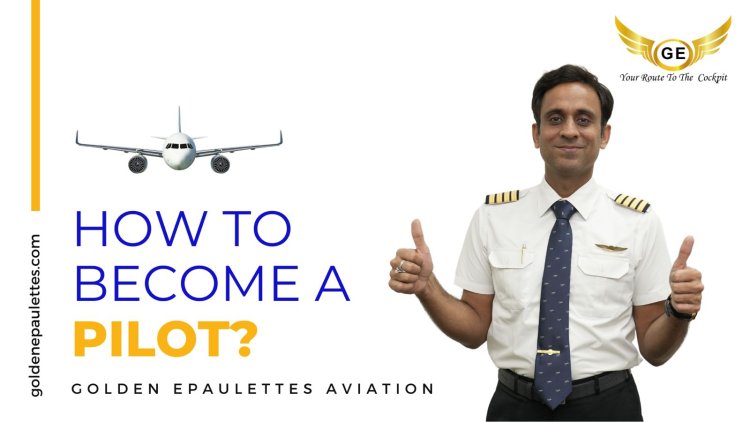How to Become a Commercial Pilot: Step-by-Step Guide
A career as a commercial pilot is both exciting and rewarding.

How to Become a Commercial Pilot: Step-by-Step Guide
A career as a commercial pilot is both exciting and rewarding. It offers opportunities to travel the world, experience different cultures, and earn a lucrative salary. If you've ever dreamed of flying an aircraft professionally, this guide will walk you through the complete process of how to become pilot and turn your aspirations into reality.
Who is a Commercial Pilot?
A commercial pilot is a professional who operates aircraft for compensation. Unlike private pilots who fly for leisure, commercial pilots can be hired for jobs such as:
-
Airline Transport
-
Cargo Transport
-
Charter Flights
-
Corporate Flights
-
Aerial Photography
-
Emergency Medical Services (EMS)
Now, let's explore the step-by-step process of how to become pilot in India.
Step 1: Meet the Basic Eligibility Criteria
Before you start your journey to becoming a commercial pilot, ensure you meet the following eligibility requirements:
✔️ Age: You must be at least 17 years old to apply for a Student Pilot License (SPL) and 18 years old for a Commercial Pilot License (CPL).
✔️ Educational Qualification: You need to have completed 10+2 with Physics and Mathematics as compulsory subjects. If you haven't studied these subjects, you can complete them through the National Institute of Open Schooling (NIOS).
✔️ Medical Fitness: You must pass the Class 1 Medical Examination conducted by the Directorate General of Civil Aviation (DGCA)-approved medical examiners.
Step 2: Enroll in a Flight Training School
Choosing the right DGCA-approved flying school is crucial for your pilot training. Here are some top flight training academies in India:
-
Indira Gandhi Institute of Aeronautics (Cochin)
-
Indira Gandhi Institute of Aeronautics (Chandigarh)
-
Capt Gopi Aviation Academy
-
Indira Gandhi Institute of Aerospace Engineering & Research
-
Indira Gandhi Institute of Aviation Technology
At a flight school, you will undergo ground training and flight training to prepare for your Commercial Pilot License (CPL).
Step 3: Obtain a Student Pilot License (SPL)
The Student Pilot License (SPL) is the first step in your aviation career. It allows you to start flight training under the supervision of an instructor. To get an SPL, you must:
✔️ Pass a written test on subjects like aviation regulations, navigation, and meteorology.
✔️ Clear a medical examination from a DGCA-certified medical examiner.
✔️ Complete a personal interview conducted by the flight school.
Step 4: Gain Flying Experience and Log Flight Hours
Once you have your SPL, you can start logging flying hours under the guidance of an instructor. The DGCA mandates a minimum of 200 flight hours to qualify for a Commercial Pilot License (CPL).
Your flight training will include:
✈️ Solo Flying Experience (Minimum 100 hours)
✈️ Cross-Country Flying (Minimum 50 hours)
✈️ Instrument Rating Training
✈️ Night Flying Experience
Step 5: Clear DGCA Theory Examinations
To obtain your Commercial Pilot License (CPL), you must pass the following DGCA exams:
???? Air Regulations
???? Aviation Meteorology
???? Navigation
???? Technical General & Technical Specific
???? Radio Telephony (RTR) Exam
These exams require extensive study and preparation, so enrolling in an aviation ground school is highly recommended.
Step 6: Obtain a Commercial Pilot License (CPL)
Once you complete 200 flight hours and pass your DGCA exams, you can apply for a Commercial Pilot License (CPL). The license allows you to work for airlines, charter companies, or corporate aviation firms.
The CPL application process includes:
✔️ Submitting all required documents (Flight logs, medical fitness reports, exam results, etc.)
✔️ Passing a flight test with a DGCA examiner
✔️ Receiving your CPL from the DGCA
Step 7: Gain Additional Ratings and Certifications
To enhance your career prospects, you can obtain additional ratings such as:
???? Instrument Rating (IR): Required to fly in low visibility conditions.
???? Multi-Engine Rating (MER): Necessary to operate larger aircraft with multiple engines.
???? Type Rating: Specific to commercial airline operations like Boeing 737 or Airbus A320.
Step 8: Apply for Jobs with Airlines
Once you have your CPL, you can apply for jobs with commercial airlines such as:
✈️ IndiGo
✈️ Air India
✈️ SpiceJet
✈️ Go First
✈️ Vistara
Airlines usually conduct an Aptitude Test, Simulator Test, and Personal Interview before selecting candidates for pilot positions.
Step 9: Obtain an Airline Transport Pilot License (ATPL)
If you aspire to become a Captain, you need an Airline Transport Pilot License (ATPL). Requirements for an ATPL include:
✔️ 1,500 flight hours of experience
✔️ Passing additional DGCA exams
✔️ Clearing simulator checks and interviews
Cost of Becoming a Commercial Pilot in India
Becoming a commercial pilot is expensive. Here’s a breakdown of the estimated costs:
-
Ground School Training: ₹2 – ₹5 lakh
-
Flight Training (200 hours): ₹30 – ₹50 lakh
-
Type Rating (for airline jobs): ₹15 – ₹25 lakh
???? Total Cost: ₹50 – ₹80 lakh
Salary of a Commercial Pilot in India
The salary of a commercial pilot depends on experience and the airline. Here’s an estimate:
-
Fresh CPL Holder (Instructor Jobs): ₹30,000 – ₹1 lakh per month
-
First Officer in Airlines: ₹2.5 – ₹5 lakh per month
-
Captain (with 5-7 years of experience): ₹7 – ₹15 lakh per month
FAQs on How to Become Pilot in India
1. Can I become a pilot without a degree?
Yes, you only need 10+2 with Physics & Math to qualify for pilot training.
2. Is there an age limit for becoming a pilot?
You must be at least 18 years old for a CPL. There is no upper age limit, but airline hiring preferences vary.
3. How long does it take to become a commercial pilot?
It takes 2 to 4 years to complete the necessary training and licensing.
4. Can I get a loan for pilot training?
Yes, many banks offer education loans for flight training.
5. What is the success rate of DGCA exams?
With proper preparation, the pass rate is 70% – 90%.
Conclusion
Now that you know how to become pilot, you can start planning your career in aviation. Becoming a commercial pilot requires dedication, hard work, and financial investment, but the rewards are worth it. Whether you dream of flying for a major airline or operating private jets, following these steps will set you on the path to success.
What's Your Reaction?

















.jpg)